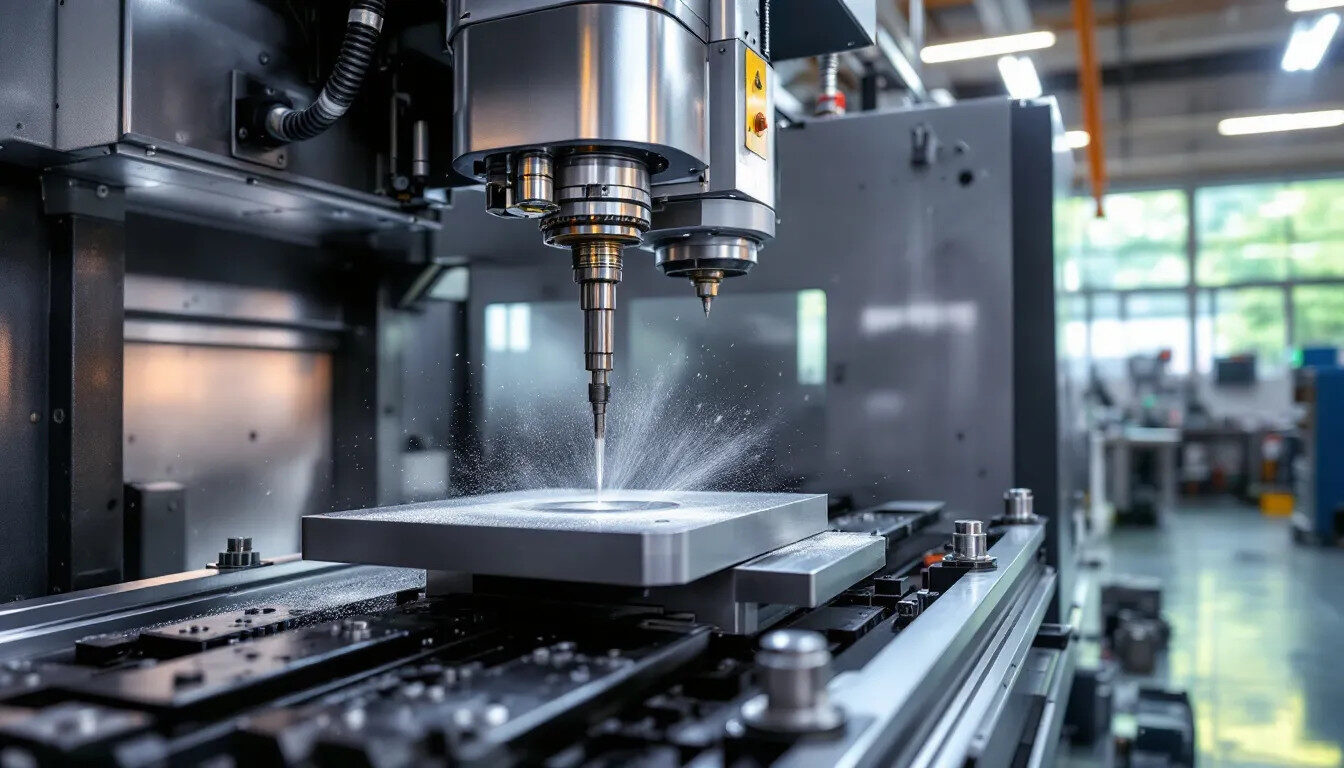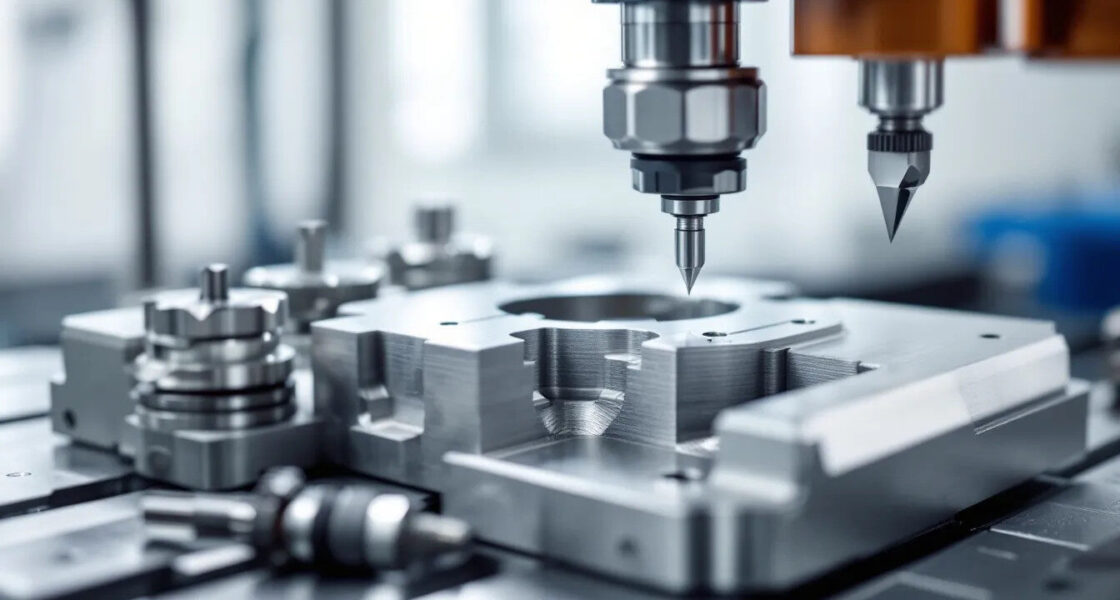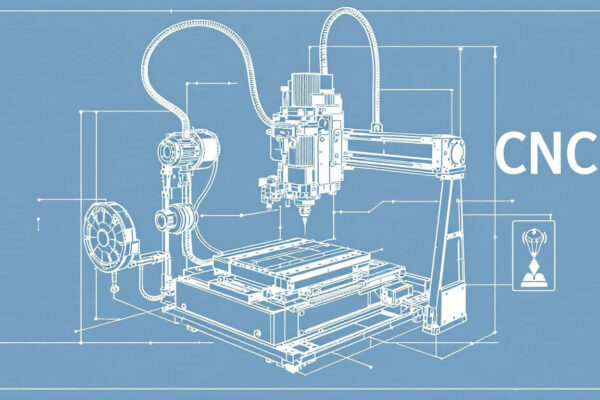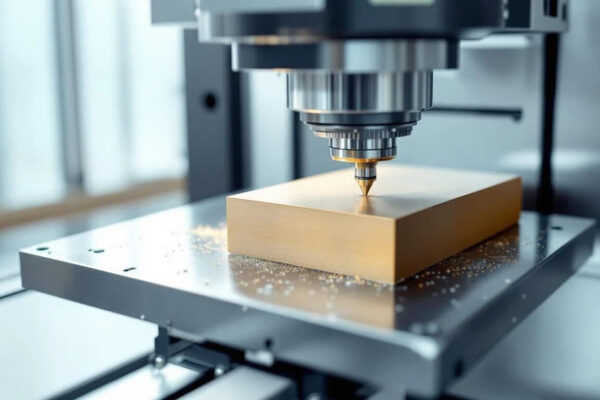Key Takeaways
- Precision CNC machining achieves tolerances as tight as ±0.0005 inches (±0.0127 mm), making it essential for aerospace, medical, and defense applications.
- The process combines computer-controlled machinery with specialized tooling to produce complex parts with exceptional dimensional accuracy and repeatability.
- Multiple machine types — including 5-axis mills, CNC lathes, and EDM systems — enable production of diverse components from various materials.
- Industries such as aerospace rely on precision components like turbine blades and engine parts that meet strict quality standards.
- Proper material selection, tooling, and process control are key factors determining precision machining success.
When aircraft components must withstand extreme forces at 40,000 feet or surgical instruments require perfect dimensional accuracy for patient safety, standard machining tolerances are no longer sufficient. This is where precision CNC machining becomes indispensable — delivering the accuracy and consistency that critical applications demand.
Precision CNC machining represents the pinnacle of computer numerical control manufacturing, achieving tolerances beyond standard machining capabilities. While conventional CNC machining typically delivers tolerances of ±0.005 inches, precision CNC machining consistently reaches ±0.0005 inches or tighter — with specialized setups achieving ±0.0001 inches.
This guide explores all aspects of precision CNC machining — from processes and equipment to materials and applications. Whether you’re an engineer specifying components or a procurement professional assessing suppliers, this article provides the knowledge needed to leverage this technology effectively.

Understanding Precision CNC Machining
Precision CNC machining is a computer-controlled manufacturing process achieving tolerances between ±0.0005” and ±0.002”, significantly tighter than standard machining. It uses advanced software and high-precision machinery to remove material with micron-level accuracy.
At its core are computer numerical control systems that use G-code and M-code to control tool movement precisely. Feedback loops and servo motors continuously monitor positioning to ensure accuracy within thousandths of an inch.
Modern machining centers include thermal compensation, automatic tool changers, and real-time monitoring to maintain consistent quality. Integration of CAD (Computer-Aided Design) and CAM (Computer-Aided Manufacturing) ensures seamless transitions from digital models to finished parts.
Precision vs Accuracy in Manufacturing
Understanding precision vs. accuracy is critical:
- Precision = repeatability — producing parts with identical dimensions, even if slightly off-target.
- Accuracy = closeness to the target specification.
Both are vital. Precision without accuracy yields consistently wrong parts; accuracy without precision leads to inconsistent results. High-end CNC machining achieves both, thanks to calibrated equipment and strict process control.
The Precision CNC Machining Process
A structured workflow ensures consistency from concept to delivery. Lead times typically range from 3–5 days for prototypes and 2–3 weeks for production runs, depending on part complexity.
Quality checkpoints occur at every stage: material verification, in-process dimensional checks, and final inspection via CMMs (Coordinate Measuring Machines).
1. Design and CAD Development
CAD models define geometry, tolerances, surface finishes, and material specs. Engineers apply Design for Manufacturability (DFM) principles — ensuring tool access, proper workholding, and achievable tolerances.
Critical dimensions are identified early, along with required inspection methods.
2. CAM Programming and Tool Path Generation
CAM software translates CAD data into precise tool paths. Simulation prevents collisions and optimizes cutting parameters for speed and precision.
Machine-specific post-processing ensures compatibility with each CNC controller.

3. Machine Setup and Workholding
Proper alignment, tool calibration, and fixture selection are essential for repeatable accuracy.
Thermal stability procedures — such as pre-run warm-ups and environmental control — prevent dimensional drift.
4. Machining Operations
Cutting parameters (spindle speed, feed rate, depth) are carefully balanced.
Coolant systems, in-process monitoring, and adaptive control maintain temperature stability and detect tool wear.
Effective chip evacuation ensures smooth finishes and extended tool life.
5. Quality Control and Inspection
CMMs, optical comparators, and laser scanners verify parts with sub-micron precision.
SPC (Statistical Process Control) monitors production trends, preventing deviation.
For regulated industries, full traceability documentation ensures compliance.
Types of Precision CNC Machines
Different machines suit different needs. The right choice depends on geometry, tolerances, materials, and volume.
Multi-Axis CNC Milling Centers
5-axis machines offer unmatched flexibility, machining complex parts from multiple angles without repositioning — minimizing tolerance stack-ups.
Spindle speeds up to 30,000 RPM enable efficient cutting of both soft and hard materials.
Horizontal centers excel in high-volume runs; vertical centers are ideal for simpler geometries.
CNC Turning Centers and Lathes
Best for cylindrical components (shafts, bushings, etc.), achieving tolerances of ±0.0005”.
Modern lathes with live tooling can perform milling, drilling, and tapping in one setup — reducing errors and setup time.
Swiss-type machines are ideal for long, slender parts.
Electrical Discharge Machining (EDM)
Wire EDM produces 2D profiles with tolerances to ±0.0001”, while Sinker EDM forms 3D cavities.
EDM is ideal for hardened materials (60+ HRC) and intricate shapes.
Surface finishes down to 0.1 μm Ra are achievable — often without secondary polishing.

Precision Grinding Systems
Surface grinding, cylindrical grinding, and centerless grinding represent the ultimate in dimensional accuracy and surface finish achievement. These precision machining processes can achieve dimensional tolerances of ±0.0001” to ±0.0002” while producing surface finishes from 0.1 to 3.2 μm Ra.
Grinding applications are essential for hardened components and critical surfaces where dimensional accuracy and surface finish requirements exceed the capabilities of conventional machining. Many precision components require final grinding operations to achieve their specified tolerances and surface characteristics.
The grinding process removes very small amounts of material with each pass, enabling precise control over final dimensions. This characteristic makes grinding ideal for achieving final tolerances on precision components where small dimensional adjustments are needed.
Precision grinding systems often incorporate in-process measurement and automatic size control, ensuring consistent dimensional accuracy throughout production runs. These closed-loop systems can automatically compensate for wheel wear and thermal effects to maintain tight tolerances.
Materials for Precision CNC Machining
Material selection significantly impacts the success of precision cnc machining operations, affecting achievable tolerances, tool life, surface finish, and overall part quality. Understanding material characteristics and their machinability helps manufacturers choose appropriate base materials for their precision components.
Material certification and traceability requirements are particularly important for aerospace, medical, and defense applications. Complete documentation of material properties, chemistry, and source ensures compliance with industry standards and regulatory requirements.
Precision Grinding Systems
Grinding achieves the tightest tolerances (±0.0001”–±0.0002”) and smoothest finishes (0.1–3.2 μm Ra).
Used for hardened surfaces and final dimensional tuning.
In-process measurement systems automatically compensate for tool wear.
Materials for Precision CNC Machining
Material choice directly affects tolerances, tool life, and finish.
Metals
- Aluminum (6061-T6, 7075-T6) – easy to machine, dimensionally stable.
- Stainless Steel (304, 316, 17-4 PH) – requires optimized cooling and tooling.
- Titanium (Ti-6Al-4V) – high strength-to-weight ratio; demands special techniques.
- Inconel, Tool Steels, Superalloys – for extreme environments, requiring advanced tooling.
Engineering Plastics & Composites
- PEEK, PTFE – tight tolerances (±0.002”), biocompatible, chemical-resistant.
- Carbon Fiber Composites – need special cutting tools to prevent delamination.
- Thermal management and post-machining treatments (e.g., annealing) ensure dimensional stability.
Industries and Applications
Aerospace & Defense
Tolerances of ±0.0005” are common. Parts include turbine blades, housings, and engine components.
Suppliers must meet AS9100 and ITAR standards for documentation and traceability.
Materials: titanium, Inconel, and aerospace-grade aluminum.
Medical & Healthcare
Precision CNC machining supports surgical tools, implants, and prosthetics where biocompatibility and FDA or ISO 13485 compliance are vital.
Surface smoothness and perfect fit ensure safety and longevity.

Automotive
Used for engines, transmissions, and fuel systems where tight tolerances improve efficiency and reliability.
Suppliers follow IATF 16949 standards with SPC and continuous improvement practices.
Advantages of Precision CNC Machining
- Unmatched dimensional accuracy for critical parts.
- Exceptional repeatability for large production runs.
- Capability to produce complex geometries impossible with manual methods.
- Material and cost efficiency through simulation and optimized toolpaths.
- 24/6 unattended production with modern “lights-out” CNC systems.
Selecting a Precision Machining Partner
Evaluate potential suppliers by equipment capability, certifications, and process maturity.
Quality Certifications
- ISO 9001:2015 – general quality management.
- AS9100 – aerospace.
- ISO 13485 – medical.
- ITAR registration – defense compliance.
Production Capabilities
Transparent pricing and minimum order flexibility.
State-of-the-art CNC accuracy and inspection systems.
Flexible capacity from prototypes to mass production.
Typical lead times: 3–5 days (prototypes) / 2–4 weeks (production).

Frequently Asked Questions
What tolerance levels can precision CNC machining achieve?
Typical tolerances: ±0.0005” (±0.0127 mm); specialized setups: ±0.0001”. Standard CNC ≈ ±0.005”.
How does 5-axis machining improve precision?
It eliminates multiple setups, reducing tolerance stack-up and improving accuracy and surface quality.
What factors most influence cost?
Material, tolerance, geometry complexity, and volume. Tighter tolerances and exotic materials increase costs.
Can it handle both prototypes and production?
Yes. The same CNC systems used for prototypes scale seamlessly to high-volume production (up to 100,000 parts / year).
What inspection methods verify quality?
CMMs, optical comparators, laser scanners, and SPC monitoring ensure consistent part quality throughout production.




